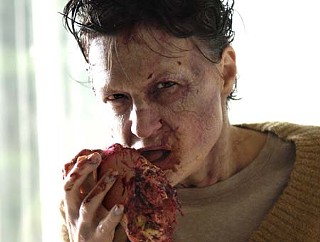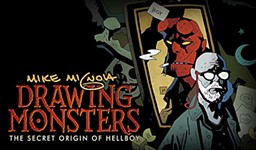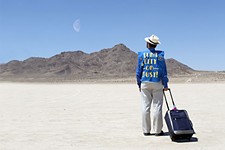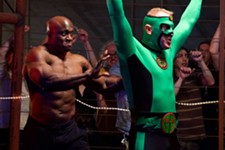Seven Days in Heaven and Hell
Getting a white-knuckled grip on the third annual Fantastic Fest
By Marc Savlov, Fri., Sept. 21, 2007
Fantastic Fest
Sept. 20-27Alamo Drafthouse Cinema (1120 S. Lamar)
Admission, program schedule, and more information: www.fantasticfest.com
Tim League, Alamo Drafthouse Cinema bigwig and prime mover behind the third annual Fantastic Fest, which opens at the Alamo South today, sounds relatively calm on the phone at T-minus seven days and counting. The note of sheer hysteric excitement that informed our earlier conversations has been replaced by anticipation of what is going to be a week of heaven for fans of the weird, the outré, and the fantastique, not to mention the Asian- and the cordite-and-copper-projectile mad.
"I must be feeling in control," League says, "because I spent the afternoon renovating our garage, which we're turning into a guest apartment for the fest. The Spaniards are staying there. I guess it's stupid to be doing that right now, because there's a million other things to do, but I feel confident enough, obviously, to do that with [wife and Alamo Drafthouse co-founder] Karrie."
There are, of course, the last-minute additions: "We just got word that Patton Oswalt is coming and Daniel Waters, the screenwriter of Heathers," League says, also noting that there's still no word on Winona Ryder, although clearly the idea of a Waters-Ryder reunion is percolating. "It's not out of the question, and we're still trying.
"What I'm doing right now is plotting out my own personal viewing schedule, actually."
Which, for the record, includes his Top 5 Fantastic Fest picks:
1) Exte: Hair Extensions
"I love this movie. It works as a straight-ahead J-horror type movie. It tweaks and mocks all of the conventions and yet, at the same time, delivers horror thrills and spills. It's also brimming with some really perverted shit. And the main character, wow. One of the most gonzo, misunderstood loony villain/hero figures ever committed to film."
2) Never Belongs to Me
"Special thanks to the New York Asian Film Festival posse for laying this one on us. The first 20 minutes are not so hot, but stick with it. As soon as the half-man/half-dog character decides to go under the knife to surgically install a penis gun, the movie kicks in to gear and never lets up."
3) Gary's Touch
"After the first festival screening of this film, the police raided the filmmaker's house to make sure he was not carrying on some sort of sick perversion in real life. This might be the sickest film I've ever seen. Because of that, I will be in the audience enjoying the audience reaction. It's one of my true delights as an exhibitor, watching an audience squirm."
4) Uncle's Paradise
"Blake Ethridge from CinemaIsDope.com first brought this to my attention. He and I share a love of the very strange and the very Asian, and this fits both bills. A weirdo Japanese pinku [softcore sex] movie with some truly wild and unexpected turns."
5) Timecrimes
"Fantastic Fest is the world premiere of this film, and the filmmaker, Nacho Vigalondo, is coming in from Spain to introduce it. This is one of the better riffs on time travel that I've ever seen; the script is fantastic. He was able to pull off an amazingly tight story with a limited budget. It's my vote for best script of the fest."
All of this year's last-minute scheduling is occurring, for the first time, without the on-site input of former Alamo Drafthouse programmer Kier-La Janisse, who was forced last July to leave the Alamo tribe unexpectedly, thanks to a then-unresolved visa/work-permit problem stemming from her Canadian residency.
"It's definitely been pretty rough, because she did so much work for us with Fantastic Fest in particular," League says. "That said, she's gone, but she has been helping out in the interim with the things that she initiated. She certainly didn't leave us high and dry or anything like that, because she's a phenomenally responsible person. What's interesting though is that Henri [Mazza] and Zack [Carlson] have been invaluable this year, even more so now that Kier-La is no longer with us in Austin. But all things considered, I think we're ready to – "
Get fantastic on our asses?
"Something like that."
Creature Teacher: George Romero on 'Diary of the Dead'
"It's a much smaller film than Land of the Dead, but I'm pleased with that. I was really able to go back to the roots; I had complete creative control for the first time in years, and it had a lower budget, so it was really a lot like going back to the beginning."
So says the once and future King of the Dead, George A. Romero, whose fourth sojourn into the twilight world between your heartbeat and their teeth – Diary of the Dead – was picked up last weekend for distribution by the Weinstein Company while at the Toronto International Film Festival.
Not bad for a self-admitted "cynical" old guy from Pittsburgh who never planned on making a sequel to his initial, legendary foray into the realm of the flesh-eater, 1968's subversive siege engine Night of the Living Dead. Now, of course, you can't go to the video store (or the Alamo Drafthouse, for that matter) without bumping into something that probably goes bump in the night and almost certainly wants to take a bite out of you, although some of them are more limber than others.
But Diary of the Dead is strictly classic zombie fare: "I had the idea to do it direct to video, initially," Romero reports, "and then the producers who wound up financing it read the script and decided to give it a little more juice and try to shoot for a theatrical release.
"The story involves a bunch of college film students that are out doing a school project making their own little horror movie, and it goes back to the first night when the dead start coming back to life. We shot it in Toronto, where I've done my last three films. It's much more like Night of the Living Dead than anything else I've done, even Dawn of the Dead."
Since the Toronto score, the online gore boards have been abuzz with the always terrifying notion that the Motion Picture Association of America's going to gut Romero's baby, leaving the viscera on the cutting-room floor in favor of saving a few teenage minds from warping. Not to worry, says Romero:
"We had to lose a few frames here and there, but not too much. It's not wall-to-wall gore, this one; it's all subjective camera, so there's no sort of ... product shots, if you will, of the guts coming out. But, you know, it's still my film, and [former KNB effects master] Greg Nicotero godfathered the effects work, and then some local guys here in Toronto who actually worked with Greg's team on Land of the Dead did the hands-on day-to-day stuff."
But what's a zombie film without a bedrock of, you'll pardon the pun, "meaty" subtext on which to spill said viscera? Recall Night of the Living Dead's Vietnam echoes, Dawn of the Dead's consumerist nightmares, Day of the Dead's existential-and-societal meltdowns, and Land of the Dead's class warfare-by-proxy.
"The subtext on this one is more societal than political," Romero says. "I got the idea from all this emerging new media, which is so pervasive now, and that's really what this film is about. It's about how we get captivated by that and we all become reporters. I mean, CNN is recruiting from the blogs, and they invite people to shoot something and send it in when something happens. And the kids in this film become compelled and become more and more involved in trying to document this thing that's happening and upload it."
And as for the zombie overload we're currently experiencing, the Z-Wars, Zombie Survival Guides, and 28 Days of Shaun-isms? There's a war on, in case you hadn't noticed, and at the end of the day – and at the beginning of the Night – it's all back to Romero's embattled farmhouse, right?
"I'm very cynical about this stuff, actually," Romero admits. "I think things come in waves, and I think maybe because of the Dawn remake and 28 Days Later, people just said, 'Hey, there's money in zombies,' rather than assume there's some greater cultural force at work. And I'm not sure how long [the fascination with zombies] is going to survive. What I think is that these creatures – and bear in mind that I didn't even call them zombies when I made the first film – are now a known thing, you know; people know the rules, thanks to the movies and the video games and books, and it's become idiomatic. People know the rules for zombies as much as they know the rules for vampires, right? Instead of garlic and crosses, it's bullets in the head. It's an available monster to use."
Ultimately, says Romero, "the ideas for all of my Dead films have all grown, in some way, out of life, either with what's happening politically or whatever. I'm not sitting around going, 'Oh, man, I've got to go do another zombie film.' I wait for something to happen or an idea to jell, and, in the case of Diary, it was just about all this new media that's exploding right now. And I'd like to go on with this idea, you know, so if the producers want to go again, I could really explore this idea much, much deeper."
Which means we can expect another Romero-directed dance with the dead somewhere down the line?
"Oh, sure," he laughs. "There's always a chance there'll be another Dead film as long as I'm still walking. And then after that, maybe I'll come back and do another one." – M.S.
Thursday, Sept. 20, 6:45pm; Romero will be in attendance.
The Intensity of Implied Violence: Ryan Thiessen on 'Five Across the Eyes'
Everyone knows that lithesome teenage girls and moonless rural roads go together like apple pie and sucking chest wounds, sure, but with so much of the current crop of so-called "new American horror" relying on the double whammy of outrageous explosions with lovingly realized gore effects coupled with borderline transgressive snarkisms (à la Eli Roth's Cabin Fever and Hostel films), is there any place for microbudgeted cinematic nightmares that seek to curdle the red stuff without resorting to the postmodern-meta-subtextualities? To paraphrase Nick Lowe: What's so funny about pieces, blood, and, um, undertakers?
Nada, says Five Across the Eyes co-directors Greg Swinson and Ryan Thiessen. This pair of kidhood pals parlayed a whopping $4,000 and a love of the genre into what's probably going to be the only five-cheerleaders-in-Mom's-minivan-meet-hell-on-a-budget feature-length white-knuckler – shot in real time, no less – to snake out of the foothills of Tennessee's Smoky Mountains ... ever. Working around a lack of obvious production strengths (no money, no-name talent, no preset distro), the Five Across guys have managed to craft a nasty little horror film that's as downright disturbing as high school and twice as bloody.
"'The Eyes' is sort of an urban legend in our area," explains Thiessen, referring to the treacherous stretch of land outside of his hometown that forms the backdrop for Five's ever-escalating horror. "I don't know that it even has a defined boundary, but it's a place that everyone knows about, and it's rumored that bad things tend to happen there.
"Greg and I had been looking for a project to do on a superlow budget, and we had a friend who had a script and gave us the story, thinking that, you know, he'd never hear from us again. So we took it and rewrote it to fit our budget and our style, and then from there we scraped together what little funds we could ... borrowed the equipment and then shot Five Across the Eyes in 10 days."
Thiessen and Swinson, who met in grade school and broke their filmmaking cherry on a backyard adaptation of the Mortal Kombat video game, freely admit that Five might not be for everyone – your mother, your little sister, and your local minivan dealer will almost certainly explode on contact – but count this one as a cannily subversive, home-groan horror show aimed at Hollywood's current infatuation with all things kinda-sorta-scary.
"I think when you put our film up against something like Hostel," Thiessen notes, "in terms of violence it doesn't even compare. Instead, we have a lot of implied violence. What we were basically going after was intensity, as opposed to, okay, here's some gore. The mood of the film and the fact that these five girls go through some truly horrific events was what we were focusing on. I think that a lot of horror [films are] missing a horrific element, and that's what we were shooting for. I don't think this is 'torture porn' at all. We were far more interested in telling a story that hits the ground running and just goes and doesn't stop. Because that's where the real horror is." – M.S.
Friday, Sept. 21, 9pm; Thiessen, Swinson, and actress Sandra Paduch will be in attendance.
Kung Pow Heartistry: Ernesto Díaz Espinoza on 'Kiltro' and 'Mirageman'
Deep within the films of the Chilean director Ernesto Díaz Espinoza lies a dream within a dream, and it is the dream of a heart within a fist within a world that rarely, if ever, shows any mercy or compassion until ... it does.
Together with his childhood friend Marko Zaror, aka "the Latin Dragon" (best known stateside as the recipient of the 2004 Stuntman of the Year award for his work doubling the Rock in The Rundown), Espinoza has helmed two of the most exhilarating martial-arts films ever made: Kiltro and Mirageman. It's not just that they're making this genuine cinematic magic in the back streets of Santiago, Chile, a country with no history of genre films (much less benevolent Bruce Lee-inspired Shaolin monkey-powisms), but that these two unlikely heroes are reimagining an entire subset of both Hollywood and Hong Kong's longest-running post-grindhouse mainstays: fists, fury, romance, and redemption. And all of it in the shadow of the Andes.
"I studied filmmaking here at the Film Institute in Chile," Espinoza says, "and also I went to Barcelona to make like a world trip of the script-writing. My friend from high school Marko Zaror was working as a stunt double in L.A. I had called him to see if there was some job there in L.A., to go and learn, and I went and lived there for a couple of years, knocked on doors, until we met Derek Rundell, the producer of Kiltro and Mirageman. We wanted to do martial-arts movies but with a little more story, you know?
"Marko was our key to getting investors, and when we got some money, we came back to Chile, and it was really easy to find the other money, because people here trusted in us because of the American money, you know? He showed me the films he loved, like the Bruce Lee movies and Sonny Chiba's films, and I showed him what I liked: David Lynch, Martin Scorsese, and Takeshi 'Beat' Kitano, especially Fireworks."
Both Kiltro and Mirageman recall the Shaw Brothers films of the Seventies while creating a whole new South American subgenre that might be called Kung Pow Heartistry: Think downtrodden, unexpected heroism with a side dish of comic compassion. Their closest recent antecedent is probably Stephen Chow's Kung Fu Hustle, which mined the same glorious vein of comic action emotion. And make no mistake: Zaror, an actor as fast on his feet as he is on his wry line readings, is already the next big thing, even if Hollywood doesn't yet recognize it. Give 'em time. After all: When was the last time a strongman from Santiago shook up the silver screen like this?
"Before, there were no real film schools [in Santiago]," Espinoza says, "and now there are young people with digital cameras making movies, and they are starting to get money from government to blow up to 35mm and show in theatres. There are people making horror films; there's us making martial arts."
And as for the siren song of Los Angeles (or, for that matter, Hong Kong)?
"At this moment I prefer working here because of the freedom," Espinoza admits. "But who knows? Maybe someday I'll go back to Los Angeles." – M.S.
Kiltro: Sunday, Sept. 23, 9:15pm; Thursday, Sept. 27, 4:15pm
Mirageman: Friday, Sept. 21, 6:30pm; Wednesday, Sept. 26, 9:35pm
Espinoza, Zaror, and Rundell will be in attendance.
To Think and Make an Effort: Karim Hussain on 'La Belle Bête'
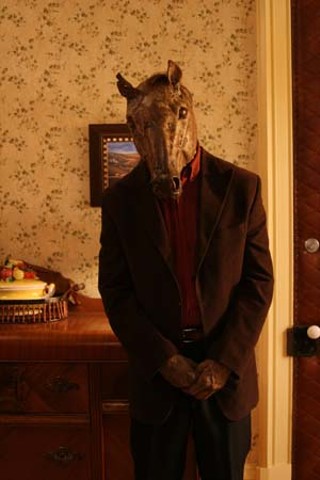
Canadian filmmaker Karim Hussain's third feature film, La Belle Bête, is a thing of immense, rapturous beauty, a dreamlike tale of children, parents, incest, love, and, yes, death, that's as far from the simplistic, retro-cool wave of current film horror as Lucky McKee's May is from Marquis de Sade's Justine. Hussain's characters seem to exist out of time in a household only a few short steps removed from some French-Canadian version of The Twilight Zone were it helmed by both Dario and Asia Argento.
"La Belle Bête," says Hussain, a former programmer for Fantastic Fest's Canadian predecessor, Fantasia Film Festival, "is a book that is, believe it or not, taught in schools in French Canada and English-speaking Canada, as well. I first encountered the book quite young, because it was actually the book that inspired my mother to become a writer, and she ended up becoming friends with the author, Marie-Claire Blais, and when I was finishing my second feature film, it was a question of, okay, what am I going to do next? Marie-Claire had actually seen my first feature, Subconscious Cruelty, which is a very extreme, very radical movie, and she enjoyed it and could see beyond the gory bits to the radicality that she thought was of value. And she just asked me, 'Do you want to make a film together?'"
Of such chance statements are the very best nightmares formed, apparently, and the finished adaptation is unlike anything you've ever seen (especially the horse-headed man).
Hussain: "I'm very inspired by European horror films, and so basically, we changed the book up somewhat to make it almost like a documentary inside this weird, vaguely European fairy tale. When the characters are in their home, it's almost as if time has stopped and they're in another era, but the minute they step outside of the house into the real world, you see that the world has progressed beyond them, which is a very intentional stylistic thing we did with the movie."
A subtitled adaptation of a French-Canadian novel written in the 1950s might not sound like your regular fantastic filmgoer's fare, but fear not, or, rather, fear something entirely new:
"Since the source material is pretty literary and to break up the kind of theatricality that the film could have, we decided to film the movie almost like a documentary and do it 80 percent handheld but still do it in CinemaScope. So it still has that painterly feel to the compositions and a lot of spatiality and duality with the framing, but just the same, we did some brighter, more gritty lighting setups than I would normally do, just to make the whole thing feel more tactile. And that's basically the way I approached adapting Marie-Claire's novel.
"My films can be difficult," Hussain says. "Not everyone who enjoyed my previous films is going to enjoy this one, although I hope that's not the case. But that's fine. This is a film that challenges you, and it's not for everybody. My films do not ask for everybody to unanimously love them. They don't have any sort of affection issues, nor do they try to suck up to the audience. They ask of the audience to actually think and to make an effort when you watch them." – M.S.
Saturday, Sept. 22, 6:15pm; Wednesday, Sept. 26, 3:45pm; Hussain will be in attendance.
Not Fucking Up the Unfilmable: Gregory Wilson and Philip Nutman on 'Jack Ketchum's The Girl Next Door'
I'm going to go out on a very short limb here and tell you right up front that Jack Ketchum's The Girl Next Door is the most disturbing film you'll see at Fantastic Fest 2007. It's the most distressing and the darkest. And, too, it might be the most affecting film you see all year. God help you.
And it's not just me saying this. Here's Stephen King's take on the film: "The most authentically shocking American film I've seen since Henry: Portrait of a Serial Killer over 20 years ago. If you are easily disturbed, you should not watch this movie. If, on the other hand, you are prepared for a long look into hell, suburban style, The Girl Next Door will not disappoint. This is the Dark Side of the Moon version of Stand by Me."
Prepare to have your dreams ruined for a long, long time.
Long considered "unfilmable," horror and suspense writer Ketchum's 1989 novel fictionalized one of the most horrific acts of American crime – the Sylvia Likens case – with unflinching honesty. Both the book and Gregory Wilson's adaptation, co-written by renowned horror novelist Philip Nutman (Wet Work) and Daniel Farrands, pull no punches in their depiction of Fifties Americana gone mad. The story, involving a pair of orphaned girls who end up in the care of a sociopathic relative and her equally unhinged brood in I Like Ike's America, takes the familiar tropes of, say, Leave It to Beaver and, yes, King's The Body/Stand by Me and guts them in a basement, in a heartbeat, in hell itself, despoiling innocence and proving once and for all that the real monsters are right next door.
"Jack Ketchum [né Dallas Mayr] is an incredibly visual writer, and when my writing partner, Daniel, called to say this was a project he thought we should tackle, I asked him, 'Do you really want to deal with this material on a daily basis for the next few months?'" Nutman says. "We had a long, soul-searching conversation about 'Could we do this material justice?' because, as I said to Dan, if we can't do this justice, regardless of the fact that Dallas is one of my dearest friends, then I don't want to do it. Because unless we can do something that is really worth making, I don't want to touch this subject matter. Jumping ahead, the rest, as they say, is history. But it really did come down to the fact that we only got the rights to do this because Dallas knew me, trusted me, respected me as a writer, although he didn't really know me as a screenwriter because I hadn't had anything filmed at that point, and he honestly thought, 'Well, they're probably going to fuck it up, but at least if they fuck it up, at least Phil's fucking it up.'"
The end result is no fuckup. But I can personally guarantee you that it will fuck you up. It's that good. It's that horrific. It's that heartbreaking. It's that real. And it's based, lest you forget, on things that really happened.
Director Gregory Wilson: "Blanche Baker, the actor who plays [sociopathic harridan-in-the-making] Ruth, is the center of gravity for the entire film. She comes from a family of actors; she was in Sixteen Candles, and the reason I cast her is that she and I both saw the character in the same way. The truth is, a lot of actors were very, very afraid to take this role and of this project. One actress told me she wanted to do the role, but she just wouldn't know how to create this character, and another told me she was just terrified of the role. I mean, flat-out terrified. But I'm extremely proud of Blanche's performance, because it is exactly how I envisioned it. She took an impossible, impossibly difficult, and unsympathetic role and not only made it her own but made it as real as, you know, your next-door neighbor."
If you live in hell, that is. – M.S.
Saturday, Sept. 22, 9:15pm; Tuesday, Sept. 25, 3:30pm; Wilson, producer Andrew van den Houten, and actor Grant Show will be in attendance.





